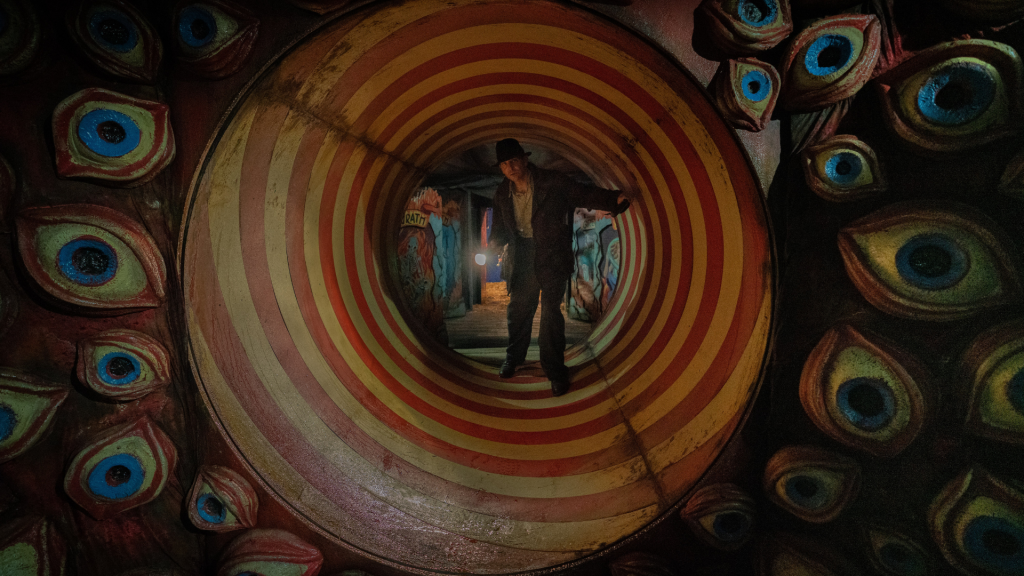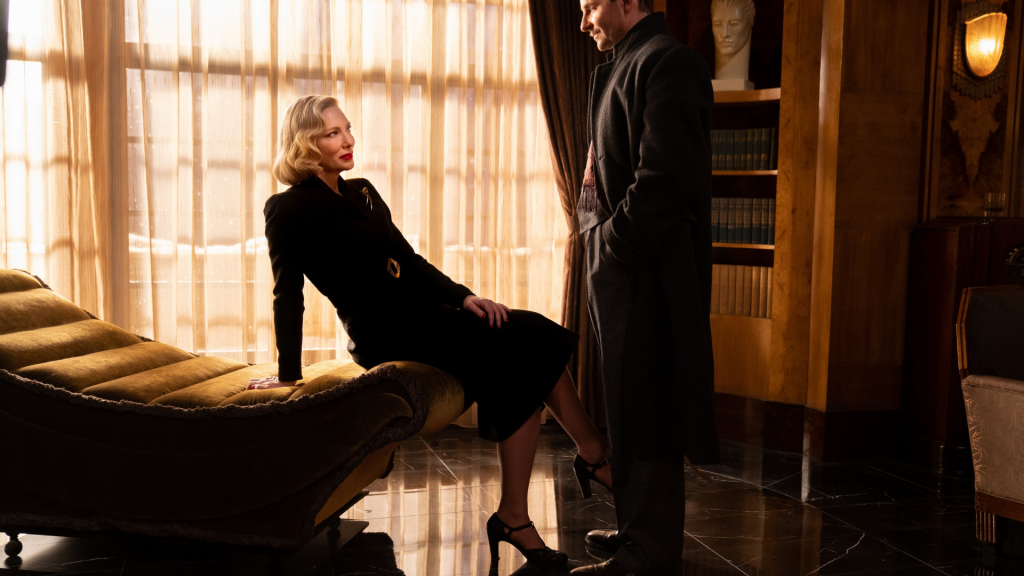Guillermo del Toro’s first film since 2018’s The Shape Of Water is a grotesque noir—but one you won’t want to take your eyes off.
★★★✰✰
“Take a look at yourself sinner” reads a funhouse sign near the start of Nightmare Alley, establishing that existentialism will play a key theme in this jaw-droppingly gorgeous noir.
Bradley Cooper plays Stanton Carlisle, a mysterious drifter who we meet in the process of torching his past. In search of a new beginning, he boards a bus and finds himself at a traveling carnival where he is promptly taken in by the troupe, none more so than a pair of ‘clairvoyants’ played by Toni Collette and David Strathairn. The two show him the ropes of their act, teaching Stanton how to read people but warning him not to engage in any ‘spook shit’. Such a talent can all too easily be used to convince people that you’re in communion with the dead, and Stanton’s teachers are all too serious about the trouble this can cause.
Nightmare Alley isn’t as steeped in fantasy as del Toro’s previous work. The clairvoyant act relies strictly on the universality of the human experience. People are easy to read, because very few of us are truly unique. Nightmare Alley pairs this theme with the tried and tested noir staple of inevitability, and there is something wonderfully engaging about knowing that some cruel fate lies in store for our protagonist, but not knowing exactly what.
Stanton thinks that he is above those in the carnival, especially Clem’s (Willem Dafoe) ‘geek’—a sad degenerate, kept caged and made to bite the heads off live chickens for paying customers. Whilst the other attractions rely, for the most part, on physical difference, there is something especially chilling about the recognisability of the geek, who is looked down upon with revulsion, but ultimately shares more in common with outsiders like Stanton.

There is very little to redeem Stanton in our eyes, besides a cute flirtation with one of the younger carnies, Molly (Rooney Mara). Their romance is the only thing with the potential to correct Stanton’s course, but we aren’t at all surprised when her guardian (Ron Pearlman) takes an instant dislike to their courtship since it’s clear that Stanton is on a direct path to trouble.
A nice little visual nod to this is the inclusion of spinning wheels hidden in the background of many shots of Stanton. Evoking the medieval concept of the Wheel of Fortune, they serve as an effective reminder that things in the carnival are about as good as they’ll get for Stanton. Elsewhere, the production design is as fantastic as we’ve come to expect from del Toro, who makes a point of collecting his film props (if you can call them that) in his personal museum named Bleak House.
Stanton’s career trajectory eventually brings him into contact with psychiatrist Dr. Lilith Ritter (Cate Blanchette) whose office is covered in wood paneling, the grain of which is strikingly reminiscent of Rorschach blotches. However, for all the beauty in Nightmare Alley’s sets, the film doesn’t quite succeed in capturing the hard-boiled noir flavor. In particular, the final act becomes regrettably bogged down in Freudian analysis, which would have been in vogue when William Lindsay Gresham’s source novel was release in the 40s—but now it just comes off as a bore.

At 140 minutes long, the film’s scope ultimately reaches too far. The world, which initially feels rich and brimming with possibility, ends up feeling sterile and lacking when the plot moves to New York. Thankfully, these scenes coincide with the introduction of Cate Blanchett who injects these dull moments with heightened urgency. Blanchett shines as a femme fetale, bringing the requisit lust and wrath to the character, whilst firmly leaning into the hamminess of the script’s second half.
The same cannot be said, sadly, for Bradley Cooper who plays Stanton far too straight. Cooper and Blanchett’s scenes are focussed around bringing Stanton’s seedy past into daylight, and so it’s such a shame that Cooper plays him firmly within the shadows. Nightmare Alley ultimately has more in common with an earlier film from del Toro, Crimson Peak, which elevated gothic horror to an absurdly camp place. In that vein, Nightmare Alley is an entertaining ride through a noir-themed funhouse, but if you’re a genre purist—my advice is to turn around.
The Verdict
Nightmare Alley is an engaging stroll down familiar territory for Guillermo del Toro. There’s plenty of fun to be had in this neo-noir piece, but it ultimately proves to be not much more than smoke and mirrors.
Words by Jake Abatan
Nightmare Alley is now showing in cinemas.
Support The Indiependent
We’re trying to raise £200 a month to help cover our operational costs. This includes our ‘Writer of the Month’ awards, where we recognise the amazing work produced by our contributor team. If you’ve enjoyed reading our site, we’d really appreciate it if you could donate to The Indiependent. Whether you can give £1 or £10, you’d be making a huge difference to our small team.
